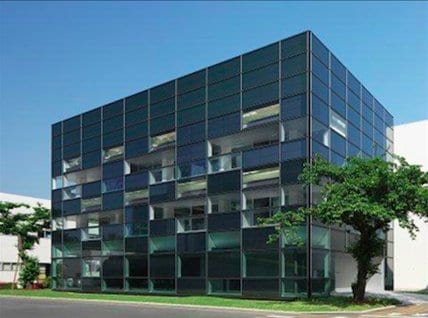In the wake of the Fukushima meltdowns, suspension of all nuclear plants (which once provided about 33% of the nation’s electricity and were slated to generate half), and subsequent head-butt from expensive fossil fuel replacement, energy resource-poor Japan is aggressively pushing forward with renewable power options.
Formerly a prominent nuclear booster, Prime Minister Shinzo Abe—now apparently a convert to “all-of-the-above”—has picked up on an initiative declared during an earlier administration. In April, Abe reaffirmed the goal of making all new public buildings zero-energy by 2020, and private buildings by 2030. (For comparison: the European Union wants its buildings to be “nearly zero-energy” by 2020, and the US Department of Energy has a 2025 goal for cost-effective commercial sites.)

Of course, these structures are not really zero-energy buildings. What they do is make up for all or nearly all their power consumption through conservation and by generating power from rooftop plus unconventional three-wall solar PV. Daytime excess goes into batteries to keep the lights on at night and on rainy days. Even the Wall Street Journal is perking up its ears at this news.
The rooftop power installation of the ZEB is nothing new. It’s the sides. Their organic PV cells, currently less efficient and more expensive than rooftop panels, are light, thin, and bendable. They thus offer great opportunity in places where ordinary panels are hard to attach. Mitsubishi Chemical intends to mass-produce the slender side panels next year.
Taisei, one of the top Japanese construction firms, just completed a zero-energy building for offices south of Tokyo that’s solar-paneled in this novel design. Opened in May as part of the Yokohama Smart City Project, the structure is on track to have net-zero energy use by the end of its first year of operation, if not sooner. The rooftop and government-supported all-wall solar panels generate all the power the zero-energy building needs. Although it’s still grid-connected, it can send as well as draw power.
Conservation measures include not only motion sensors for lighting, but also wind direction sensors that signal workers when it makes sense to open a window. Air-conditioning comes through floor vents to each desk, so workers can fine-tune the amount of cool air and its direction.
Taisei says its three-story Yokohama office structure cuts energy down to a quarter of that used by conventionally powered buildings of similar capacity. While in 2010 Europe and the US accounted for 70% of ZEB construction, Nomura Research Institute predicts that Asia will account for about half of the global market by 2030.
Japan’s Kajima Corporation, a 170-year-old concern that built Japan’s first nuclear reactor in 1957 and is also known for high-rise, tunnel, and bridge construction, says it wants to build a medium- or high-rise zero-energy building for offices by 2020, and Obayashi Corporation, like Taisei among the nation’s top five construction companies, is considering a “life-cycle zero-energy building” that even pays off all the energy used in materials and construction.
Though the side-panel tech is still expensive and not yet on the market commercially, Taisei President Takashi Yamauchi compared the achievement to a concept car, capable through mass production of recouping the owners’ investments within a feasible time frame. One way to lower costs would be to make the side panels more efficient. Investors hope today’s 5% conversion rate will rise to about 20% by 2020.
The company foresees expanding the concept to Japan’s crowded cities. The government agrees. Said Kimihiro Hashimoto, director-general of the Japan land ministry’s housing bureau,” Zero-energy buildings could be one of the key pillars for our growth strategy.”
Source: CleanTechnica. Reproduced with permission.










